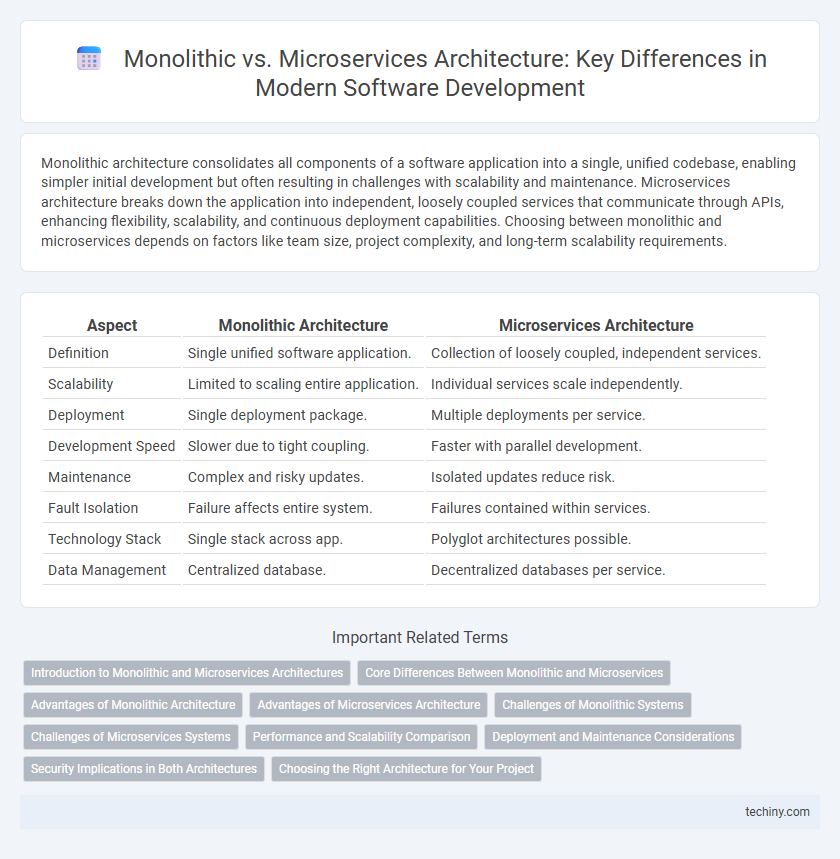Monolithic architecture consolidates all components of a software application into a single, unified codebase, enabling simpler initial development but often resulting in challenges with scalability and maintenance. Microservices architecture breaks down the application into independent, loosely coupled services that communicate through APIs, enhancing flexibility, scalability, and continuous deployment capabilities. Choosing between monolithic and microservices depends on factors like team size, project complexity, and long-term scalability requirements.
Table of Comparison
| Aspect | Monolithic Architecture | Microservices Architecture |
|---|---|---|
| Definition | Single unified software application. | Collection of loosely coupled, independent services. |
| Scalability | Limited to scaling entire application. | Individual services scale independently. |
| Deployment | Single deployment package. | Multiple deployments per service. |
| Development Speed | Slower due to tight coupling. | Faster with parallel development. |
| Maintenance | Complex and risky updates. | Isolated updates reduce risk. |
| Fault Isolation | Failure affects entire system. | Failures contained within services. |
| Technology Stack | Single stack across app. | Polyglot architectures possible. |
| Data Management | Centralized database. | Decentralized databases per service. |
Introduction to Monolithic and Microservices Architectures
Monolithic architecture structures an application as a single, unified unit where all components are interconnected and managed in one codebase, facilitating straightforward deployment but often leading to scalability challenges. Microservices architecture breaks down an application into independent, modular services that communicate over networks, enabling greater flexibility, easier scaling, and faster development cycles. This architectural approach supports continuous integration and deployment, making it ideal for complex, evolving software systems.
Core Differences Between Monolithic and Microservices
Monolithic architecture consolidates all components of a software application into a single, unified codebase, simplifying deployment but limiting scalability and flexibility. Microservices architecture decomposes applications into independent, loosely coupled services, each responsible for specific functionalities, which enhances scalability, maintainability, and fault isolation. Core differences include deployment complexity, scalability options, development velocity, and technology stack diversity, with microservices enabling faster innovation and resilience compared to the tightly integrated monolithic approach.
Advantages of Monolithic Architecture
Monolithic architecture offers advantages such as simplified development and deployment processes due to its unified codebase, which enables faster performance and easier debugging. It provides strong consistency and straightforward testing as all components run within a single process, reducing network latency. This architecture suits smaller teams and projects requiring tight integration and simplicity in management.
Advantages of Microservices Architecture
Microservices architecture offers enhanced scalability by allowing individual services to be deployed and scaled independently, optimizing resource utilization. It improves fault isolation, minimizing the impact of failures on the overall system, which leads to higher availability and resilience. Development teams benefit from greater agility and faster releases through decentralized deployment and technology diversity, enabling continuous integration and delivery.
Challenges of Monolithic Systems
Monolithic systems often face challenges such as limited scalability, as the entire application must be scaled rather than individual components. The tightly coupled architecture complicates updates and maintenance, increasing the risk of system-wide failures during deployment. Additionally, monolithic applications can hinder continuous integration and deployment practices due to their complexity and interdependence.
Challenges of Microservices Systems
Microservices systems face challenges such as increased complexity in managing distributed services, requiring robust orchestration and communication mechanisms. Scalability issues arise due to the need for independent service deployment and coordination, while ensuring data consistency across services remains difficult. Monitoring and debugging are more demanding compared to monolithic architectures because of the decentralized nature of microservices environments.
Performance and Scalability Comparison
Monolithic architectures often exhibit faster inter-process communication and simpler performance tuning due to their unified codebase, but they struggle with scalability as the entire system must scale together, leading to resource inefficiencies. Microservices enable independent scaling of specific components based on demand, improving resource utilization and supporting large-scale distributed workloads, though they introduce network latency and complexity in inter-service communication. Performance optimization in microservices requires robust orchestration and monitoring tools to mitigate overhead and ensure seamless scalability across diverse environments.
Deployment and Maintenance Considerations
Monolithic applications require straightforward deployment as a single unit but pose challenges in scaling and updating specific components without impacting the entire system. Microservices architecture enables independent deployment of services, allowing for faster updates, scalability, and fault isolation, though it demands sophisticated orchestration and monitoring tools like Kubernetes and Prometheus. Maintenance in microservices involves managing service dependencies and network latency, whereas monolithic systems often face higher risks of downtime during updates due to tightly coupled components.
Security Implications in Both Architectures
Monolithic architectures centralize security controls, making it easier to enforce consistent permissions but increasing the risk of a single point of failure that can compromise the entire application. Microservices, distributed across multiple services, require robust inter-service authentication, authorization, and network segmentation to prevent lateral movement by attackers. Implementing end-to-end encryption, API gateways, and container security are critical in mitigating vulnerabilities inherent to the distributed nature of microservices.
Choosing the Right Architecture for Your Project
Choosing the right architecture for your software development project depends heavily on scalability, deployment speed, and team structure. Monolithic architectures offer simplicity and easier initial deployment, making them suitable for smaller applications with limited complexity. Microservices provide greater flexibility and scalability by decomposing applications into independent services, ideal for large, complex projects requiring rapid iteration and continuous delivery.
Monolithic vs Microservices Infographic

 techiny.com
techiny.com